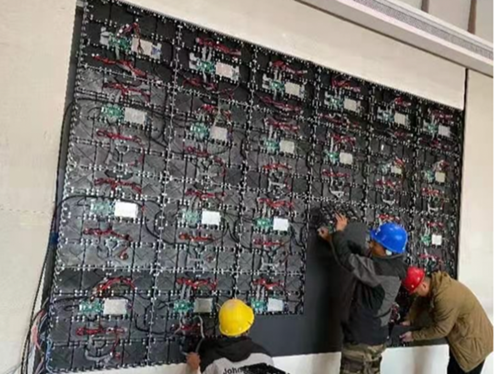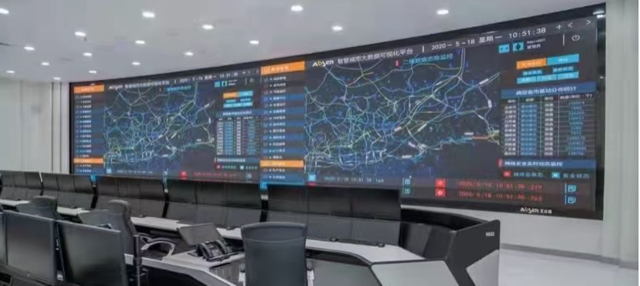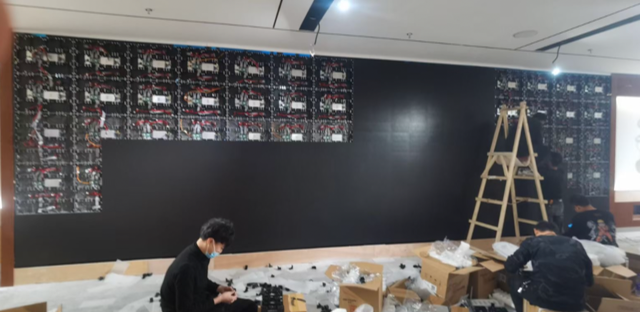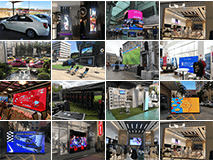
Whether you plan to rent indoor LED video walls that are in a prime location, or lease or purchase them and install them at your own event space, the cost is often easily offset through the sheer amount of exposure you can achieve in a short period. There are, however, some common pitfalls to consider and avoid. Let's take a look at what you need to know to create a flawless video experience.
1. Understanding the Space
Before even considering implementing a video wall, it's imperative that you understand the space that you'll be occupying. These factors will come into play when determining the appropriate size, brightness, pixel pitch, resolution and power requirements of the video wall you'll rent or purchase. Also, consider the other elements that will be present in the space – if you're setting up for a trade show and only have a small booth, a large video wall may be overpowering to attendees and detract from your main message.
2. Understanding the Business Goals of Using a Video Wall
Before undertaking any visual implementation, the technology coordinator must consider the business goals associated with this strategy. How will a video wall improve and promote your message versus the promotion you're currently undertaking? For example, in an event environment, a video wall is extremely useful for displaying event sponsor content, directing attendees to various areas of the venue grounds and keeping guests entertained with engaging visuals, among other things.
3. Understanding Common Content Issues
There are several common problems that people without design experience can run into when developing content for video displays. Let's explore a few.
Small, unreadable text – When designing content, make letters large, at least a fourth of the screen and use a sans serif font. Some designers create super small text that might look nice on their laptop screen when they create it, but looks bad on the video wall. Additionally, depending on the pixel pitch you use, shades or glossy effects on text may not be needed. Despite its size, many video walls contain many fewer pixels than a computer screen, meaning they are not as detailed. In other words, it's virtuously pointless to create shadows or shining effects on a three-inch letter that looks great on a computer, but isn't viewable on a video wall with spaced out pixels.
Content is too long – whether a sponsor's message overstays its welcome, or a block of text is too big and chunky, content that's too long is a common problem among amateur designers or event advertisers. Short, simple messages will always be more effective on a digital sign. Take, for example, a billboard on the highway: when a person is driving 70 mph, they just don't have the time to take in a 30-second advertisement. Likewise, people aren't sitting down on their couch when they're at an event, they're dealing with a ton of distractions and are probably moving about – that's why it's important to present an easily digestible message. The general rule of thumb is to limit the length of video wall content to around 10 seconds.
Creating a unified display – the main goal when implementing video wall technology is to create a unified display, not several individual screens that appear pieced together. Those black bars in between the screens can get very distracting and interrupt the flow of your content. The capabilities of your video wall's hardware and software will dictate how content appears on the screen. Design any content within the video wall dimensions to make the most of the technology's capabilities. Remember, such factors as pixel pitch and screen resolution will also have a huge impact on the quality of your displayed content.
Creating visual hierarchy – If the visual order of the content doesn't make any sense, the viewer will have more difficulty understanding the message. Always put the most important part of your message at the forefront of what you show. You don't want your message to get lost in the noise, so make it the most prolific element on the slide, changing its color to be different than other text or background, or even repeating it more than once may prove beneficial.
4. Understanding the Technical Capabilities of Video Wall Content
Videos, images, audio, text other content will need to be optimized for the type of video wall you're using. Nothing makes a video wall look more unprofessional than tiny, unreadable font and low-resolution images. Both should be large and clear enough to easily understand. Remember: Even though content looks awesome on a laptop screen, it might not translate to the hugeness of video walls. Always build video wall content with big screens in mind.

5. Understanding Brightness and Power
When renting or purchasing a video wall, it's important to consider the brightness level. First of all, will your event be indoor or outdoor? Direct sunlight can have very damaging effects on viewing quality if the brightness isn't properly set. In a similar vein, if the screen is too bright at night-time or when the lights are turned off, viewers can strain their eyes. Below are the guidelines for determining nit requirements (nit being the unit of measurement for LED brightness):
Indoor Brightness: 1,000 – 1,500 nits
Outdoor Brightness: 2,000 – 3,000 nits
Outdoor Brightness Under Direct Sunlight: LED panels may need to output as much as 5,000+ nits
When dealing with more brightness, you're also dealing with higher power requirements. The majority of video walls have various power requirements. Let's say you have a 4-millimeter outdoor panel that requires a single 20-amp breaker for every five panels. So, for a video wall that is six panels wide by five panels high, you would have a power requirement of six 20-amp breakers.
6. Understanding Pixel Pitch, Viewing Distance and Screen Resolution
Pixel pitch – which refers to the distance from the center of an LED cluster/pixel to the center of the next LED cluster/pixel, measured in millimeters, and directly correlates your display resolution – is key to a solid viewing experience.
Pixel pitch is important in determining minimum required viewing distance for a clear image. A smaller pixel pitch produces a higher-resolution video wall which the viewer can stand closer to and still see the content clearly. The higher the pitch is, the farther the required viewing distance. So, wouldn't you want smaller pixel pitch all the time? Not necessarily.
By having a smaller pixel pitch, you increase the number of individual pixels on a display. For example, a video wall larger than 100 inches with a 4-millimeter pitch can easily contain more than 200,000 pixels. A 6-millimeter pitch on the same size display would have fewer than 100,000. With the rise in pixels, comes a rise in cost. Fortunately, if your audience isn't going to be standing right next to the screen, you can reduce your pixel pitch and save your budget.
7. Taking Advantage of Interactivity
While an interactive video wall isn't a necessity, it can make for a great end-user experience and enhance event engagement. You can implement interactivity into a video wall, either by using a touch display or via an application on a mobile device that augments the content.
As a technical event coordinator, it's your duty to view your video wall setup through the eyes of the intended audience. How will they best benefit from a wall's interactivity? Consider the types of content that will be displayed on the video wall – whether it's a virtual product demonstration, in-house network programming, social media feeds, audio-visual enhancements or static images.
Additionally, ask yourself if touch will add value to the content. Depending on where the installation is and the type of environment, it may be overbearing to some. Another option is to install a smaller touchscreen display in front of the video wall for a less-intimidating interaction, keeping the video wall as the main display and the smaller screen for interaction.
8. Working with an Experienced Systems Integrator
Once you do decide on the best video wall for your event's needs, you'll need someone with experience operating displays. These technology professionals can help you with the proper installation and mounting solutions, screen calibration and alignment, test and fix any poorly optimized content, as well as respond in the event of a technology crisis. Unless you have experience operating video walls, you may put your event at risk of display failure, which would be disastrous.
Additionally, you may want to get the help of an installation expert. Because video walls are installed in unique ways, they will have an easier time with service, maintenance and display leveling, among other installation tasks.
NSE Indoor LED Video Wall

Advantages:
1. Ultra-thin design. The thickness of the whole screen is only 55mm.
2. Modular design.
There are mainly 2 series.
One module size is 320*160mm, corresponding to the box is 640*640mm, 640*480mm.
The other module size is 250*250mm, corresponding to the box size is 1000*250mm, 500*500mm, 500*250mm,
3. Quick installation.
4. Save installation cost. No need for special mounting brackets. 5.
5. Allows right angle design.
If you need more information about the NSE Indoor LED Video wall or to get a quote, please feel free to contact us!

 English / America
English / America 简体中文 / 中国
简体中文 / 中国 Español / España
Español / España Italiano / Italia
Italiano / Italia














